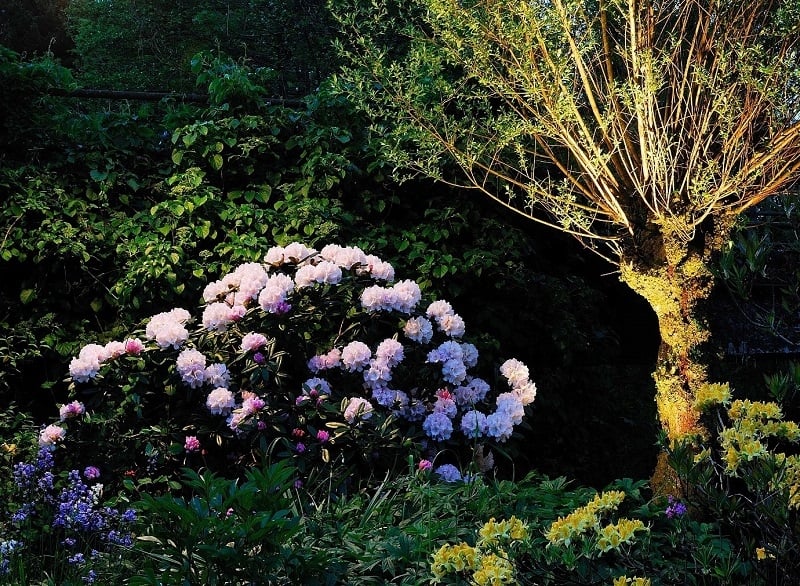

Author: Brendon Manggos
Lighting for Gardens Technical Sales Manager
This is a guide to lighting trees, not instructions on lighting trees. Every tree is unique like a finger print; you may have 2 Oak trees illuminated with the same light fittings but their features or structure may differ and more than likely, you will end up with slightly different results.
Deciding which tree to light and which technique to use requires some consideration. Lighting a large tree close to an exterior viewpoint, like a patio, may have striking results if the light output can be shielded from view. A tree close to the house may not be worth lighting though, as it may be difficult to see from a window. The further the tree is from the house the more brightly it should be lit to prevent it fading away in the distance; items closer to the house will always catch your eye first. If you have trees near a path, rather than uplighting which may cause glare, try moonlighting from just above the lower branches, to create an interesting effect of light and shadows on the ground below. Moonlighting may also be used at the end of a path to help draw your attention to a specific part of the garden.
Some key lighting tips for trees
Where the shape of the tree falls within a 35-45° arc, use a single medium beam uplight.
If the tree has a wider spread, over 10m, use 2 or more uplights for a fuller effect.
Where the canopy is open, use a single medium uplight at the base of the trunk and light up through the canopy.
When the foliage is especially dense, as in conifers, position the light just outside the canopy and graze up the foliage to emphasize it’s texture.
Which type of light shall I use?
This guide aims to remove some of the guesswork when specifying tree lighting products. Trees vary enormously in size and shape, but most trees can be lit very well using fittings with 36° or 60° beam angles.
Narrow trees such as Silver Birch, Scots Pine and most conifers work best with a 36° light source. Medium spreading trees like Robinia, Cherry or Lime need lights with a 60° beam angle. While wide spreading mature Oaks and Cedars will usually require more than one light to achieve reasonable coverage. Extremely narrow subjects such as Italian Cypress could be lit using a very narrow light source, but in practice a 36° light will usually be effective.
If a tree has an open canopy the light can be placed close to the trunk and pointed upwards to good dramatic effect. But where the foliage is dense it is better to light it up from the edge of the canopy. Grazing the outside in this way emphasizes textures and avoids the lower branches blocking the light from reaching the top.
Good quality recessed fittings are available but surface mount fittings are easier to install and are more versatile. Ideally you should test out the lighting positions in the dark before making any final decisions. Unfortunately in the real world this is not always possible. In practice, it is much easier to move a spike mounted light than a recessed fitting. Make sure the lights are installed with a bit of slack cable to allow for adjustment.
Most broadleaved trees look most comfortable when lit using a warm white 3000 kelvin light source. By contrast some conifers such as Cedrus Atlantica Glauca and other specimens with blue-grey foliage look positively sick when lit with a warm white lamp. Much better to use a crisp white 4000 - 5000 kelvin light source because it makes the foliage come alive.
Larger trees require something much more energy efficient such as metal halide or LED. Metal halide is a very good light source but it does suffer from one major drawback. The lamp must be matched to the control gear which means you can’t change the lamp brightness later on. Also the lamps can’t easily be dimmed.
LED’s are rapidly improving and there are now LED lights capable of lighting large trees. If you require a light with a very wide spread you could consider some of the new 30w, 50w or 100w LED floodlights. But positioning is critical - none of them offer any real glare control.
For lighting very small trees you might consider one of the Compact Spike Spots (available in 12v or 240v) with a 5w or 7w led. If you need recessed fittings the Modula range of lights are a good choice; very solidly built with adjustable lamp holders which you can angle up to 30°, also available in 12v or 240v. If you are using 60° lamps it is worth considering P520B and Taurus spike spots which have excellent glare control without constricting the light distribution.
Slightly larger trees (3 -5 metres) need more light than you can get from a single spike spot. You could consider the Titan 10w LED 240v spike spot.
Trees up to about 8 metres can be lit effectively using 35w metal halide lamps in spike mount or recessed fittings or some of the larger LED lights like the Titan 26w or the Athena recessed LED uplight.